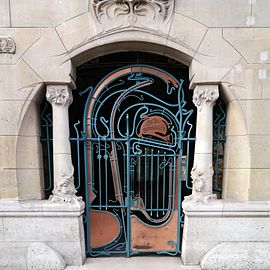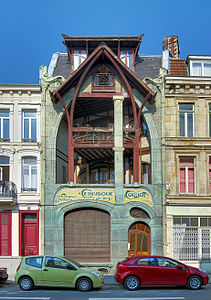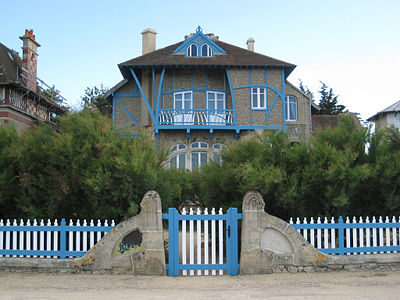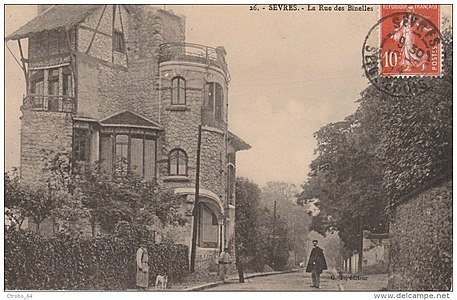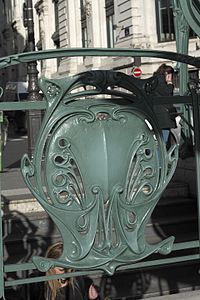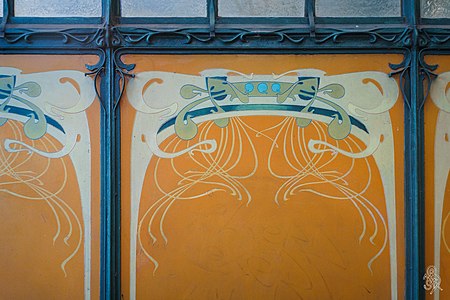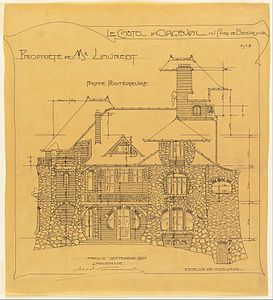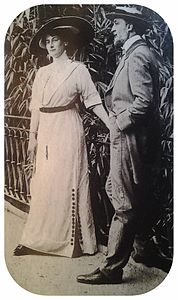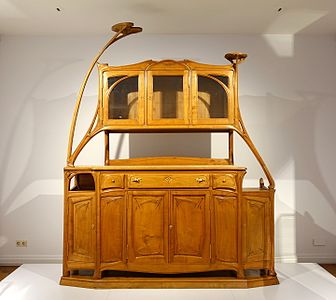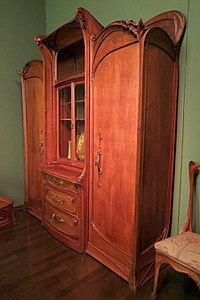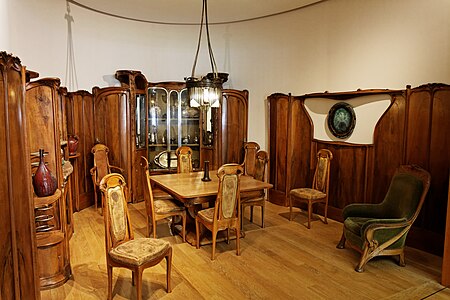Hector Guimard: Difference between revisions
→Furniture: adding image and caption to gallery |
m Duplicate word removed |
||
| Line 114: | Line 114: | ||
== Furniture == |
== Furniture == |
||
Like other prominent Art Nouveau architects, Guimard also designed furniture and other interior decoration to harmonise with his buildings. It took him some time to find his own style in furniture. The furniture he designed for the Hotel Delfau (1894), which he put on display at an Exposition in 1895, was picturesque and ornate, with a sort of star motif, which seemed to have little connection with the architecture of the house. His early furniture sometimes featured had long looping arms and lateral shelves and levels for displays of objects. He apparently did not produce any furniture for the Hotel Beranger, other than a desk and chairs for his own studio there. In his early years he is known to have produced only two full sets of furniture, a dining room set |
Like other prominent Art Nouveau architects, Guimard also designed furniture and other interior decoration to harmonise with his buildings. It took him some time to find his own style in furniture. The furniture he designed for the Hotel Delfau (1894), which he put on display at an Exposition in 1895, was picturesque and ornate, with a sort of star motif, which seemed to have little connection with the architecture of the house. His early furniture sometimes featured had long looping arms and lateral shelves and levels for displays of objects. He apparently did not produce any furniture for the Hotel Beranger, other than a desk and chairs for his own studio there. In his early years he is known to have produced only two full sets of furniture, a dining room set for the Castel Henriette and a dining room for the Villa La Bluette.He also designed furnishings without any particular room in mind, as he did with watercolor designs for the Russian Princess Maria Tenisheva in 1903. {{Sfn||Vigne (2016)|page=151-152}} |
||
His furniture style began to change in about 1903. He found a workshop to make his furniture, and began using finer woods, particularly pear wood, with delicate colors. He simplified he plans, and eliminated the excessive number of arms and shelves. The most notable examples of his late style are found in the rooms of the [[Hotel Guimard]], now in the [[Petit Palais]] and the [[Musée des Arts Decoratifs]] in Paris, and [[([[Musée des Beaux-Arts de Lyon]]]]. {Sfn||Vigne (2016)|page=151-152}} |
His furniture style began to change in about 1903. He found a workshop to make his furniture, and began using finer woods, particularly pear wood, with delicate colors. He simplified he plans, and eliminated the excessive number of arms and shelves. The most notable examples of his late style are found in the rooms of the [[Hotel Guimard]], now in the [[Petit Palais]] and the [[Musée des Arts Decoratifs]] in Paris, and [[([[Musée des Beaux-Arts de Lyon]]]]. {Sfn||Vigne (2016)|page=151-152}} |
||
Revision as of 15:07, 15 February 2020
Hector Guimard | |
|---|---|
 Hector Guimard (1907) | |
| Born | 10 March 1867 Lyon, France |
| Died | 20 May 1942 (aged 75) New York City, United States |
| Nationality | French |
| Occupation | Architect |
| Buildings | |
Hector Guimard (10 March 1867 – 20 May 1942) was a French architect and designer, and a prominent figure of the Art Nouveau style. He achieved early fame with his design for the Castel Beranger, the first Art Nouveau apartment building in Paris, which was selected in an 1899 competition as one of the best new building facades in the city. He is best known for the glass and iron edicules or canopies, with ornamental Art Nouveau curves, which he designed to cover the entrances of the first stations of the Paris Metro.[1]
Between 1890 and 1930, Guimard designed and built some fifty buildings, in addition to one hundred and forty-one subway entrances for Paris Metro, as well as numerous pieces of furniture and other decorative works.[2] However, by the 1960s, Art Nouveau was out of fashion, most of his works had been demolished, and only two of his original Metro entrances were still in place.[3]. Guimard's critical reputation revived in the 1960s, in part due to subsequent acquisitions of his work by Museum of Modern Art, and art historians have noted the originality and importance of his architectural and decorative works.[2]
Early life and education
Hector Guimard was born in Lyon on 10 March, 1867. His father, Germain-René Guimard, was an orthopedist, and his mother, Marie-Françoise Bailly, was a linen maid. His parents married on 22 June 1867. His father became a gymnastics teacher at the Lycée Michelet in Vanves in 1878, and the following year Hector began to study at the Lycée. In October 1882 he enrolled at the École nationale supérieure des arts décoratifs, or school of decorative arts. He received his diploma on 17 March 1887, and promptly enrolled in the École des Beaux-Arts, where he studied architecture, He received honorable mention in several architectural competitions, and also showed his paintings at the Paris Salon des Artistes in 1890, and in 1892 competed, without success, in the competition for the Prix de Rome. In October 1891 he began to teach drawing and perspective to young women at the École nationale des arts decoratifs and later a course on perspective for younger students, a post he held until July 1900. [4]
He showed his work at the Paris Salons of April 1894 and 1895, which earned him a prize of a funded voyage first to England and Scotland, and then, in the summer of 1895, to the Netherlands and Belgium. In Brussels in the summer of 1895 he met the Belgian architect Victor Horta, one of the founders of Art Nouveau, and saw the sinuous vegetal and floral lines of the Hotel Tassel, one of the earliest Art Nouveau houses. Guimard arranged for Horta to have an exhibition of his designs at the January 1896 Paris Salon, and Guimard's own style and career began to change.[5]
Early works - the Castel Béranger (1895-1898)
The earliest constructed work of Guimard was the cafe-restaurant Au Grand Neptune (1889), located on the Quai Auteuil in Paris at the edge of the Paris Universal Exposition of 1889. It was picturesque but not strikingly innovative. It was demoiished in 1910. He constructed another picturesque structure for the Exposition, the Pavilion of Electricity, a showcase for the work of electrical engineer Ferdinand de Boyéres. Between 1889 and 1895 he constructed a dozen apartment buildings, villas and houses, mostly in the Paris 16th arrondissement or suburbs, including the Hotel Roszé (1891) and the Hotel Jassedé (1893) without attracting much attention. He earned his living primarily from his teaching at the School of Decorative Arts. [6]
Guimard's first recognized major work was the Castel Béranger in Paris, an apartment building with thirty-six units constructed between 1895 and 1898, when the architect was just thirty years old. at 14, rue Jean de la Fontaine, Paris, for Mme. Fournier. He persuaded his client to abandon a more restrained design and replace it with a new design in a more modern style, similar to that of Horta's Hotel Tassel, which he had visited in the summer of 1895.[5] Guimard put together an extraordinary number of stylistic effects and theatrical elements on the facade and in the interior, using cast iron, glass and ceramics for decoration. The lobby, decorated with sinuous vine-like cast iron and colorful ceramics, resembled an undersea grotto. He designed every detail, including the wallpaper, rain spouts and door handles, and added adding highly modern new features including a telephone booth in the lobby. [7].
A skilled publicist, Guimard very effectively used the new building to advertise his work. He had his own apartment and office in the building. He organized conferences and press articles, set up an exhibition of his drawings in the salons of Le Figaro, and wrote a monograph on the building. In 1899 He entered it into the first Paris competition for the best new building facades, and in March 1899 it was selected one of the six winners, a fact which he proudly had inscribed on the facade of the building.[7]
- Facade of the Castel Béranger
- Gateway
- Entrance hall
- Balcony decoration
- Exterior decoration
Castels, Villas and a short-lived Concert Hall
The success and publicity created by the Castel Beranger quickly brought him commissions for other residential buildings. Between 1898 and 1900 he constructed three houses simultaneously, each very different but recognizably in Guimard's style. The first, the Maison Coilliot, was built for the ceramics manufacturer Louis Coilliot on rue de Fleurs in Lille, and sarved as his store, reception hall and residence. The facade was covered with plaques of green enamelled volcanic rock, and decorated with soaring arches, curling wrought iron, and Guimard's characteristic asymmetric, organic doorways and windows. [8]
The following year, 1899, while he continued to teach regularly at the school of decorative arts in Paris, and continued construction of the Maison Coilliot, he began three new houses; The Modern Castel or Villa Canivet in Garches was Guimard's reinvention of a medieval castle. La Bluette in Hermanville-sur-Mer was Guimard's update of traditional Norman architecture. and the Castel Henriette, in Sevres. The Castel Henriette was the most inventive. It was located on a small site, almost circular, and was crowned with a tall, slender watchtower. To create more open interior space, Guimard moved the stairwell to the side of the building. The interior wss lit by large windows, and featured ensembles of furniture all designed by Guimard. The building had an unhappy history. The watchtower fell in 1903, apparently after being struck by lightning. Guimard was summoned back and redesigned the house, adding new balconies and terrace. However, by the 1960s, the building was considered out of fashion, and it was rarely occupied. It served as a movie set before it was finally demolished, despite appeals by preservationists. Some of the furniture is now found in museums.[8]
In 1898 Guimard embarked upon another ambitious project, the construction of a concert hall, the Salle Humbert-de-Romans, located at 60 Rue Saint Didier (16th arrondissement). It was built as the centrepiece of a conservatory of Christian music intended for orphans, proposed by a Dominican monk, Father Levy. Guimard made an ambitious and non-traditional plan using soaring levels of iron and glass, inspired by an early idea of Eugene Viollet-le-Duc. An organ manufacturer, in consolation with Camille Saint-Saens, donated a grand organ. The Salle was completed in 1901, but a scandal involving Father Levy and the orphans broke out. Father Levy was exiled by the Pope to Constantnople, the foundation was dissolved, and the concert hall was used only for meetings and conferences. It closed in 1904 and was demolished in 1905. The grand organ moved to the church of Saint-Vincent-de-Pual in Clichy, where it can be found today. [9] [10]
- The Maison Coilliot in Lille (1898-1900)
- Villa La Bluette in Hermanville-sur-Mer, Calvados (1899-1900)
- Castel Henriette, Sevres (1899-1900))
- Castel Henriette after the removal of the watchtower
- The Salle Humbert-de-Romans (1898-1905)
- Colored postcard of the interior of the Salle-Humbert-de-Romans
Paris Metro entrances
The highly-publicized debut of the Hotel Béranger quickly brought Horta new projects, including villas, a Paris concert hall, and, most famously, entrances for the stations of the new Paris Metro, which was planned to open in 1900 in time for the Paris Universal Exposition. A new organization, the chemin de fer métropolitan de Paris (CFP, now RATP) was created in April 1899 to build and manage the system. They organized a competition for station entrance edicules, or canopies, and balustrades, or railings. This attracted twenty-one applicants. Guimard did not apply. The twenty-one original applicants proposed edicules built of masonry, in various historic and picturesque styles. These were ridiculed in the press as resembling newspaper stands, funeral monuments, or public toilets. Time was short, and Guimard presented sketches of his own idea for entrances made of iron and glass, which would be quicker and simpler to manufacture. He was given the commission on 12 January 1900, just a few months before the opening of the system.[11]
To simplify the manufacture, Guimard made two designs of edicules, called Type A and B. Both were made of cast iron frames, with cream-colored walls and glass roofs to protect against rain. The A type was simpler and more cubic, while the B was rounded and more dynamic in form, and is sometimes compared with a dragonfly. Only two of the original A types were made and neither still exists. Only one B type, restored, remains in its original location, at Porte Dauphine. [12]
Guimard also designed a simpler version, without a roof, with railings or balustrades of ornamental green-painted iron escutcheons and two high pylons with lamps and a 'Métropolitain' sign. The pylons were in an abstract vegetal form he invented, not resembling any particular plant, and the lettering was in a unique which Guimard invented. These were the most common type.[12]
From the beginning, Guimard's Metro entrances were controversial. In 1904, after complaints that the new Guimard balustrade at the Opera station was not in harmony with the architecture of the Palais Garnier opera house, the Metro authorities dismantled the entrance and replaced it with a more classical model. Garnier was sarcastic in his response in the Paris La Press of Paris on October 4, 1904. "Should we harmonise the station of Père-Lachaise with the cemetery by constructing an entrance in the form of a tomb?...Should we have a dancer with her leg raised in front of the station at place Dame-Blanche, to harmonise with the Moulin-Rouge?" [12]
From the beginning, Guimard was also in conflict with the Metro authorities about his payments. The dispute was ended in 1903 with an agreement by which Guimard received payment, but gave up his models and manufacturing rights. Construction of new stations continued using his design without his participation. A total of 167 entrances were installed, of which sixty-six still survive, mostly in locations different from their original placement. [12]
- Porte Dauphine Métro station, the only surviving entrance in its original location
- Abbesses station entrance
- Railing escutcheon with "M", Quatre-Septembre
- Lamps and "Métropolitain" sign, Anvers
- Design on wall panel of édicule, Porte Dauphine
Late Villas
In the early years of the 20th century, Guimard's popularity diminished and his earlier frenetic pace of production slowed down. His works shown at the 1903 Paris Exposition of residential architecture did not attract the attention of the Castel Beranger and other earlier work. He was supported largely by one wealthy client, Léon Nozal, and his friends. His works for this group included the La Sapiniere, a small beach house at Hermanville-sur-Mer, near his earlier La Bluette house; La Surprise, a villa at Cabourg; and the Castel Val at Auvers-sur-Oise. In Paris he constructed the Hotel Nozal on Rue Ranelagh for his friend; the Hotel Jassadé for Louis Jassadé on Avenue de Versailles; and the palatial Castel d'Orgeval, which was the centrepiece of a new residential development at Villemoisson-sur-Orge in the Paris suburbs.[13]
- Drawing of the Castel d'Orgeval by Guimard (1904)
- Plan of the Castel d'Orgeval drawn by Guimard (1904)
- La Sapinière (facade considerably modified from Guimard's original facade) (1907)
The Hôtel Guimard
The most important work of this period is the Hotel Guimard, built in 1909 at 122 Avenue Mozart (XVIth arrondissement) in Paris, ten years after his first success with the Hotel Beranger. It was built following his marriage on with Adeline Oppenheim, an American painter from a wealthy family. The land was purchased three months after the marriage, and in June 1910 Guimard was able to move the offices of his agency into the ground floor. The house was not occupied by the couple, however, for two more years, while the furniture he designed was manufactured. The house is located on a triangular lot, which proved a particularly challenge for Guimard. He saved interior space by installing an inclined elevator rather than a stairway on the upper floors. The house was designed to show its functions on the facade; his wife could paint in one portion of the house, with large windows, while he worked in his bureau in another part of the house. It had a very large dining room and many tables, but no kitchen; it was apparently designed for working and entertaining. The house was later broken up into apartments, and the original room arrangements and furniture are gone.[14]
- Hector Guimard with his wife Adeline, around 1910
- Facade of the Hôtel Guimard. The studio of his wife was behind the large windows on the top floor.
- Early photo of the main facade, with original windows
- Madame Guimard's bedroom (1909)
- Dining room (c. 1910). The house had a large dining room but no kitchen.
The Synagogue of rue Pavée and later works
Guimard was no longer the leader of Paris architectural fashion, but he continued to design and build residences, apartment buildings, and monuments. One notable work of this period is the Agoudas Hakehilos Synagogue at 10 Rue Pavé (IV arrondissement) in the Marais district, which was begun in 1913 and completed on June 7, 1914, just a few weeks before the beginning of the First World War.
Between 1914 and 1939 he designed projects but built only a small number of new buildings. He completed an office building at 10 rue de Bretagne, a private home, the Hôtel Nicolle de Montjoye, on what is now rue René Bazin, and a parking garage on rue Robert-Turquan (16th arrondissement), all later demolished. In 1921-22, he built a small house at 3 Square Jasmin (16th arrondissement) designed to be a model for a series of standard houses, but it was not duplicated. In 1925 He participated in the Paris Exposition of Decorative and Modern Arts, the Exposition which gave its name to Art Deco, with a proposed model of a town hall for a French village. He also designed and built several war memorials and funeral monuments.
Just before the First World War he had created a firm, the Sociéte géméral de constructions modernes, with th intention of building standardized housing at a modest price. Following the war, in 1920-21, he requested patents for a series of different techniques for making standardized houses, but he was unable to keep up with the rapid changes in styles and methods. His firm was dissolved in July 1925. He also continued to receive honors, particularly for his teaching at the École national des arts decoratifs. In February 1929 he was named a Chevalier in the French Legion d'honneur. Thinking [15]
Between 1926 and 1930 he built several residential buildings in the same neighborhood as his home in the 16th arrondissement, which still exist. These included the Hôtel Houyvet, at 2 Villa Flore and 120 Avenue Mozart, built for the industrialist Michel Antoine Paul Houyhvet. His last recorded work was La Guimardière, an apartment building on Avenue Le Nôtre, Vaucfresson in the Hauts-de-Seine suburb of Paris. It was completed in about 1930, but was demolished in March-April 1969. [15]
As early as 1918 he took steps to assure that his work would be documented and would survive. He obtained space in the former orangerie of the [[Château de Saint-Germain-en-Laye], where he deposited models of his buildings and hundreds of designs. In 1936 he donated a large collection of his designs to Alfred Barr, the director of the Museum of Modern Art in New York. IN 1937 he received authorisation to put thirty cases of models in the cellars of the National Museum of Antiquities in Saint-Germaine-en-Laye. [15]
- Agoudas Hakehilos Synagogue rue Pavée, Paris, 1913
- Interior of the Agoudas Hakehilos Synagogue
Furniture
Like other prominent Art Nouveau architects, Guimard also designed furniture and other interior decoration to harmonise with his buildings. It took him some time to find his own style in furniture. The furniture he designed for the Hotel Delfau (1894), which he put on display at an Exposition in 1895, was picturesque and ornate, with a sort of star motif, which seemed to have little connection with the architecture of the house. His early furniture sometimes featured had long looping arms and lateral shelves and levels for displays of objects. He apparently did not produce any furniture for the Hotel Beranger, other than a desk and chairs for his own studio there. In his early years he is known to have produced only two full sets of furniture, a dining room set for the Castel Henriette and a dining room for the Villa La Bluette.He also designed furnishings without any particular room in mind, as he did with watercolor designs for the Russian Princess Maria Tenisheva in 1903. [16]
His furniture style began to change in about 1903. He found a workshop to make his furniture, and began using finer woods, particularly pear wood, with delicate colors. He simplified he plans, and eliminated the excessive number of arms and shelves. The most notable examples of his late style are found in the rooms of the Hotel Guimard, now in the Petit Palais and the Musée des Arts Decoratifs in Paris, and [[(Musée des Beaux-Arts de Lyon]]. {Sfn||Vigne (2016)|page=151-152}}
- Divan for the billiards room of pharmacist Albert Roy at Gévriles (1897-90) (Musée d'Orsay, Paris)
- Buffet of cherry wood, brass, and glass (1899-1900) (Bröhan Museum, Berlin)
- Side chair of pear wood and leather (1900) (Bröhan Museum, Berlin)
- Armoire, Hôtel Nozal (1904-1906)
- Furnishings for the bedroom of Madame Guimard, Hôtel Guimard (1909-12) (Musée des Beaux-Arts de Lyon)
- Dining room in the Hotel Guimard (Petit Palais, Paris)
- Dressing table from bedroom of Madame Guimard (1909-1912)
Death, Obscurity and Rediscovery
Guimard served as a member of the jury judging architectural works at the 1937 Paris Exposition, where he could hardly miss the monumental pavilion of Nazi Germany. His wife was Jewish, and he was alarmed by the rising likelihood of war. In September, 1938, he and his wife settled in New York City. He died on May 20, 1942 at the Hotel Adams on Fifth Avenue. He is buried in Gate of Heaven Cemetery in Hawthorne, New York, about 25 miles north of New York City.[17]
After the War, in June-July 1948, his widow returned to Paris to settle his affairs. She offered the Hotel Guimard as a site for a Guimard Museum first to the French state, then to the City of Paris, but both refused. Instead, donated three rooms of Guimard's furniture to three museums; the Museum of Fine Arts of Lyon, the Museum of Decorative Arts in Paris, and the Museum of the Petit Palais, where they are now displayed. She also donated a collection of three hundred designs and photographs to the Museum of Decorative Arts These disappeared into various archives the 1960s, but were relocated in 2015. His widow died on 26 October 1965 in New York.[18] [17]
By the time of Guimard's death, many of his buildings had already been demolished or remodeled beyond recognition. Most of his original Metro station edicules and balustrades had also been removed. The only full covering remaining at its original location at Porte Dauphine. However, many original architectural drawings by Guimard are stored in the Dept. of Drawings & Archives at Avery Architectural and Fine Arts Library at Columbia University in New York City.
Of the [Paris Métro]] station entrances, only one roofed ridicule remains at its original location, at Porte Dauphine. Reconstructed edicules are found at Abbesses and Châtelet. A number of the original balustrade entrances remain or have been rebuilt.
The Guimard Style
Principles which encouraged architectural competitions, innovation upon the past, provided the basis for his development of his idiosyncratic form of Art Nouveau, referring to the outputs of the popular classicism of time as "cold receptacle of various past styles in which the original spirit was no longer alive enough to dwell"[2]. So much did Guimard depart from the classical tradition that his peers at the Arts Decos' named him the "Ravachol of architecture", after the church bombing political activist Ravachol.[2] In 1884 he was awarded three bronze and two silver medals at the school for his work. In 1885 he received awards in all of the competitions at Arts Decos' including four bronze medallions, five silver, and the school's Grande Prix d'Architecture.
The Castel Béranger made Guimard famous and he soon had many commissions. He continued to develop his own form of Art Nouveau, especially devoted to the ideal of harmony and continuity, which caused him to design the interior furnishings and decoration of his buildings as well. This approach culminated between 1909 and 1912 when he created his own home, Hôtel Guimard[19] (his wedding present to his rich American wife) where ovoid rooms[20] contained unique pieces of furniture which are considered integral parts of the building.
If the skylights favored by Victor Horta are rather absent in his work (except in his 1910 Mezzara Hotel), Guimard made noteworthy experiments in space and volume. Some of these include the Coilliot House[21] and its disconcerting double-frontage (1898), La Bluette[22] and its beautiful volumetric harmony (1898), and especially the Castel Henriette[23] (1899) and the Castel d'Orgeval[24] (1905), radical demonstrations of a vigorous and asymmetrical "free plan", twenty-five years before the theories of Le Corbusier. But other buildings of his, like the splendid Nozal Hotel,[25] (1905), employ a rational, symmetrical, square-based style like that of Viollet-le-Duc.
Guimard also employed some structural innovations, as in the concert hall Humbert-de-Romans[26] (1901), where a complex frame divided sound waves resulted in perfect acoustics (built 1898 and sadly demolished in 1905), or as in the Hôtel Guimard (1909), where the ground was too narrow to have the exterior walls bear any weight, and thus the arrangement of interior spaces differs from one floor to another.[27]
In connection with Guimard's advocation of modernisation was his pioneering of industrial standardisation, insofar as he wished to diffuse the new art on a large scale. His greatest successes here – in spite of some scandals – were his entrances to the Paris Métro,[28] based on the ornamented structures of Viollet-le-Duc. Guimard’s approach to the metro is said to have been a response to the heaviness of traditional architecture.[29] The idea was taken up – but with less success – in 1907 with a catalogue of cast iron elements applicable to buildings: Artistic Cast Iron, Guimard Style.[30] Guimard's art objects have the same formal continuity as his buildings, harmoniously uniting practical function with linear design, as in the Vase des Binelles,[31] of 1903.
His inimitable stylistic vocabulary has suggestions to plants and organic matter and has been described as a form of "abstract naturalism"[2]. Undulating and coagulating forms are found in every material from stone, wood, cast iron, glass (Mezzara hotel, 1910), fabric (Guimard hotel, 1909), paper (Castel Béranger, 1898), wrought iron (Castel Henriette, 1899), and ceramic (Coilliot House, 1898); Guimard compared it analogously to the flowing of sap running from a tree, referring to the liquid quality found in his work as the "sap of things".[2] Guimard's structural forms remain only as abstract evocations of nature and never directly indicative of any particular plant, an approached outlined by the art critic and contemporary, Gustave Soulier who said about Guimard's work:
"we do not see... clearly recognisable motifs which are only interpreted and regularised by a geometric ornamental convention. But neither is it merely withered and graceless floral or animal skeletons that Mr. Guimard draws. He is inspired by the underlying movements, by the creative process in nature that reveals to us identical formulas through its numerous manifestations. And he assimilates these principles in the formation of his ornamental contours... the floret is not an exact representation of any particular flower, Here is an art that both abbreviates and amplifies the immediate facts of Nature; it spiritualises them. We are present at the birth of the quintessence of a flower."[2]
Selected list of buildings
- Hôtel Mezzara, 60 rue La Fontaine, Paris, 1910
- Agar Building
- 1888 Café Au grand Neptune (quai d'Auteuil, 16th arrondissement de Paris).
- 1889 Pavilion of Electricity at the 1889 World's Fair in Paris.
- 1890 Construction of a small dwelling in Billancourt (Monsieur Lecolle, owner)
- 1891 Hôtel Roszé (rue Boileau, 16th arrondissement of Paris)
- 1894 Hôtel Jassedé (rue Chardon-Lagache), Hôtel Delfau (rue Molitor), and the funerary chapel of Devos-Logie and Mirand-Devos in the cimetière des Gonards at Versailles. Guimard meets Belgian architects Victor Horta and Paul Hankar, and visits Hotel Tassel of Horta.
- 1895 Atelier Carpeaux (boulevard Exelmans, Paris), and the École du Sacré Cœur. Beginning of construction on the Castel Béranger (rue Jean de la Fontaine, Paris).
- 1896 La Hublotière au Vésinet.[32]
- 1897 Guimard moves into an apartment building. Coilliot House.
- 1898 Castel Béranger which is called "deranged" by contemporaries.
- 1899 Villa Bluette (Hermanville, Calvados).
- 1900 Coilliot House (14, rue Fleurus, Lille); design of the entrances, buildings and lettering of the stations entrance of the Paris Métropolitan (of 141 entrances created, 58 survive, including one moved to Montreal, plus four reproductions in Chicago, Lisbon, Mexico City, and Moscow)
- 1901 Salle Humbert-de-Romans (Paris); Castel Henriette (rue des Binelles, Sèvres, Hauts-de-Seine).
- 1903 Castel Val (4, rue des Meulières, Auvers-sur-Oise); Villa La Sapinière (Hermanville).
- 1904 Castel Orgeval (2 avenue de la Mare-Tambour, Villemoisson-sur-Orge); Hôtel Léon Nozal (16th arrondissement of Paris).
- 1905 Hôtel Deron Levet, Chalet Blanc (2, rue du Lycée, Sceaux).
- 1909 Immeuble Trémois, rue Agar; Guimard marries Adeline Oppenheim and they move into the Hôtel Guimard on a triangular lot on the Rue Mozart, Paris.
- 1910 Hôtel Mezzara (60, rue Jean de la Fontaine, 16th arrondissement de Paris)
- 1913 Synagogue de la rue Pavée à Paris (10, rue Pavée, in the 4th arrondissement de Paris); Villa Hemsy (3, rue Crillon, Saint-Cloud).
- 1924 Villa Flore (avenue Mozart, 16th arrondissement de Paris).
- 1926 Apartment building (rue Henri Heine, Paris).
- 1928 Apartment building (rue Greuze, Paris). It applies an Eternit tubular system as a tribute to his friend Henri Sauvage who patented the warmth supply for him.[33]
- 1930 La Guimardière, Avenue Le Notre, Vaucression, Hautes-de-Ssine. Demolished March-April 1969 [34]
Gallery
- Hôtel Mezzara, 60 rue La Fontaine, Paris, 1910
See also
- Art Nouveau in Paris
- Paris architecture of the Belle Époque
- Concours de façades de la ville de Paris which he won in 1900
Notes
- ^ Vigne, Georges, Hector Guimard - Le geste magnifique de l'Art Nouveau, (2016), Editions du Patrimoine, Centre des Monuments National, p. 40
- ^ a b c d e f g Graham, F. Lanier (1970). Hector Guimard. New York: The Museum of Modern Art. pp. 4–14.
- ^ "The Story Behind Paris' Iconic Art Nouveau Metro Entrances". My Modern Met. 2019-05-01. Retrieved 2020-02-05.
- ^ Vgne, Georges, Hector Guimard - Le Geste Magnifique de l'Art Nouveau (2016), pp. 197
- ^ a b Vigne (2016), p. 197.
- ^ Vigne (2016), p. 188.
- ^ a b Vigne (2016).
- ^ a b Vigne (2016), pp. 66–83.
- ^ Vigne (2016), p. 190.
- ^ Fernand Mazade, « An "Art Nouveau" Edifice in Paris, The Architectural Record, vol. 12, no 1, May 1902, p. 51-66 (consultable on archive.org)
- ^ Vigne (2016), pp. 85–103.
- ^ a b c d Vigne (2016), pp. 88–89.
- ^ Vigne (2016), p. 126.
- ^ Vigne (2016), p. 126-127.
- ^ a b c [[#CITEREF|]].
- ^ & Vigne (2016), p. 151-152.
- ^ a b Vigne (2016), p. 198.
- ^ "Adeline Oppenheim Guimard 1872-1965 artiste et mécène". www.academia.edu (in French). Retrieved 12 February 2020.
- ^ Hôtel Guimard d'Hector Guimard, lartnouveau.com
- ^ Salle à manger, lartnouveau.com
- ^ Maison Coilliot à Lille, lartnouveau.com
- ^ La Villa La Bluette, lartnouveau.com
- ^ Accueil, lecercleguimard.com
- ^ Guimard (5t.jpg Archived 2007-03-02 at the Wayback Machine, aplressources.free.fr
- ^ L'Hôtel Nozal d'Hector Guimard, lartnouveau.com
- ^ Salle Humbert de Romans Archived 2013-04-12 at archive.today, lecercleguimard.com
- ^ Lartnouveau.com
- ^ "Parisinconnu.com". parisinconnu.com.
- ^ Kuma, Kengo, 1954- (2008). Anti-object : the dissolution and disintegration of architecture. Architectural Association (Great Britain). London: Architectural Association. ISBN 978-1-902902-52-4. OCLC 67375498.
{{cite book}}: CS1 maint: multiple names: authors list (link) CS1 maint: numeric names: authors list (link) - ^ Panneau central de grand balcon Archived 2005-05-28 at the Wayback Machine, insecula.com
- ^ Vase des Binelles en grès - (Musée national Adrien Dubouché) Archived 2005-09-08 at the Wayback Machine, musee-adriendubouche.fr
- ^ La hublotière - Hector Guimard - Redirect by ulimit.com Archived 2009-02-24 at the Wayback Machine, hublotiere.fr.st
- ^ Giusti, F. (2016). Ruderi industriali e materiali sperimentali, nel quadro della conservazione del patrimonio del XX secolo: gli elementi tubolari in eternit dell’immeuble de rapport di Rue Greuze 38, a Parigi, di Hector Guimard (pdf) (in Italian and English). Vol. 23. University of Florence. p. Abstract. doi:10.13128/RA-18444. ISSN 1724-9686. OCLC 8349148328. Archived from the original on February 14, 2020. Retrieved February 14, 2020 – via archive.is.
{{cite book}}:|journal=ignored (help); External link in|via= - ^ Vigne (2016), p. 194.
Bibliography
- Vigne, George (2016). Hector Guimard - Le geste mangnifique de l'Art Nouveau (in French). Paris: Editions du Patrimoine - Centre des monuments nationaux. ISBN 978-2-7577-0494-3.
{{cite book}}: Invalid|ref=harv(help)
External links
- Hector Guimard architectural drawings and papers, circa 1903-1933, (bulk circa 1903-1929).Held by the Department of Drawings & Archives, Avery Architectural & Fine Arts Library, Columbia University.
- Le Cercle Guimard
- lartnouveau.com - The work of Hector Guimard in Paris and in France
- art-nouveau-around-the-world.org Hector Guimard
- Guimard's works in the Cooper-Hewitt, National Design Museum
- Hector Guimard in American public collections, on the French Sculpture Census website


